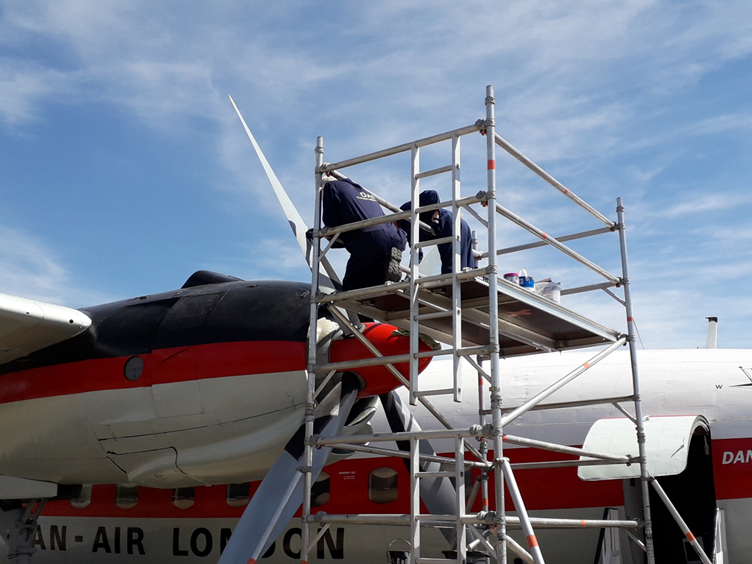


Welcome to the latest update of engineering work and stories covering the British Airliner Collection fleet.
VC10:

As you know from previous Mutterings we are attempting to replace/repolish the passenger windows on the VC10. The Tuesday team were given the task of a conducting a trial attempt to polish the severely opaque windows. After a morning of gentle sanding and buffing achieved no results it was decided to go for broke and a window was attacked with gusto by volunteer Simon with coarser sandpaper and more elbow grease. 90 mins later we had our first transparent window, sadly marred by some internal crazing. But the window now no longer has the strange four vertical lines on it that all the windows appear to have acquired. One done, who knows how many more to do.


Dave Swann has recently completed a work required survey for the VC10 and of course work also continues, as it will for some time, to attend to the underwing corrosion.


Still with the VC10, custodian Colin Tilley kindly supplied the following explanation regarding the two periscopes you can see displayed in the rear galley of the VC10. Known as the periscope and the ‘shufti-scope’ the two items were usually used by the Flight Engineer. Over to Colin:
“The Periscope was primarily used to check on the VC10’s tailplane, (predominantly the Leading edge) checking its condition during possible icing conditions whilst flying at high altitudes.
The ‘Shufti-Scope’ was used to survey the aircraft’s rear hold, in flight, viewing the hold through an access panel in the rear galley floor, to monitor electrical equipment housed there for smoke.
Unusual items to be found on a civil airliner of the day! Both are currently displayed on the VC10 in an illuminated panel in the rear galley.”

“Another very important piece of equipment installed and used on those early VC10 flights was a ‘Periscope -Sextant’, housed in the flight deck ceiling. The Navigator had the responsibility for this piece of kit, aiding him to navigate by the stars and the sun, in the many and varied regions of the world the VC10 served. A Periscope -Sextant can be seen on our VC10’s flight deck.”
Thank you Colin for that piece of interesting info. If anyone else has any stories or pictures of their projects please send them to me at kbrad1@hotmail.co.uk
BAe146:
With no ‘Royal tours’ scheduled and the threat of high winds the Tuesday team refitted the engine cover on the number one engine to prevent any damage.

The 146 interestingly has its flying controls moved by servo tabs. This means the pilot’s control column only moves a small hinged tab on the rear of the large control surface which aerodynamically ‘flies’ the control surface into the desired position. An offshoot of this is that the main control surfaces are free to move about when the aircraft is parked on the ground. It is desirable in the prevailing East Anglian ‘breeze’ to fit some kind of lock to stop the controls banging from stop to stop. These are simply made with plywood and threaded studding. The Tuesday team spent a happy morning measuring, cutting and painting a complete set ready for fitting at a later date.

Viscount:
With just four triple chair units to finish off in the workshop the end is in sight for the Viscount cabin refit. Most of the completed seats have now been replaced in the cabin mainly by the Sunday team. The Starboard side seats which had been fitted previously were not quite spaced right so John and Ian spent a day repositioning them correctly. They hope to finish fitting the port side in a couple of weeks.


Training:
DAS has always strived to ensure the continuing safety of its members and visitors. We have all been through fire training and have access to Health and Safety info via the web. Recently a round of Cherry picker training has been completed and now, after many years of head scratching, scaffold training is available! Next up will be Genie training for our new platform scissor lift.

Ambassador:
Ambassador custodians Ray and Cliff decided the props were looking a bit tatty so they have rubbed them down primed and repainted them to look like new. They have completed the starboard side and will soon be tackling the prop on the port side.


Concorde:
After guarding the gate to our yard for many years it has decided to part with the mould used to make the nose cones for Concorde. Having been outside for decades the mould needs a bit of a spruce up to make it more attractive for selling. As you can imagine this is not a small piece of Concorde memorabilia so in order to move it nearer our workshop a call was made to our colleagues at the Military Vehicle Wing for assistance. In no time at all Brian quickly arrived driving their large breakdown crane. His skill and the crane’s strength made short work of moving the mould close to the workshops so work can begin cleaning it up.


That’s it for this month. Keith
Registered Charity No. 285809